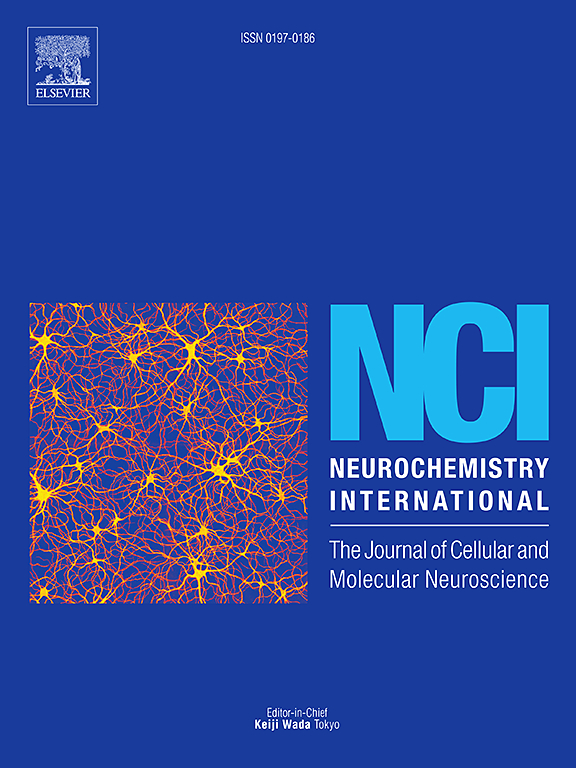The C. elegans glutamate transporters GLT-4 and GLT-5 regulate protein expression, behavior, and lifespan
IF 4
3区 医学
Q2 BIOCHEMISTRY & MOLECULAR BIOLOGY
引用次数: 0
Abstract
Glutamate transporters are important for regulating extracellular glutamate levels, impacting neural function and metabolic homeostasis. This study explores the behavioral, lifespan, and proteomic profiles in Caenorhabditis elegans strains with either glt-4 or glt-5 null mutations, highlighting contrasting phenotypes. Δglt-4 mutants displayed impaired mechanosensory and chemotactic responses, reduced lifespans, and decreased expression levels of ribosomal proteins and chaperonins involved in protein synthesis and folding. In contrast, Δglt-5 mutants displayed heightened chemorepulsion, extended lifespans, and upregulation of mitochondrial pyruvate carriers and cytoskeletal proteins. Proteomic profiling via mass spectrometry identified 53 differentially expressed proteins in Δglt-4 mutants and 45 in Δglt-5 mutants. Δglt-4 mutants showed disruptions in ribonucleoprotein complex organization and translational processes, including downregulation of glycogen phosphorylase and V-type ATPase subunits, while Δglt-5 mutants revealed altered metabolic protein expression, such as increased levels of mitochondrial pyruvate carriers and decreased levels of fibrillarin and ribosomal proteins. Gene ontology enrichment analysis highlighted differential regulation of protein biosynthesis and metabolic pathways between the strains. Overall, these findings underscore the distinct, tissue-specific roles of GLT-4 and GLT-5 in C. elegans, with broader implications for glutamate regulation and systemic physiology. The results also reinforce the utility of C. elegans as a model for studying glutamate transporters' impact on behavior, longevity, and proteostasis.
秀丽隐杆线虫谷氨酸转运体GLT-4和GLT-5调节蛋白表达、行为和寿命
谷氨酸转运体在调节细胞外谷氨酸水平、影响神经功能和代谢稳态方面具有重要意义。本研究探讨了glt-4或glt-5零突变秀丽隐杆线虫菌株的行为、寿命和蛋白质组学特征,突出了表型的差异。Δglt-4突变体表现出机械感觉和趋化反应受损,寿命缩短,参与蛋白质合成和折叠的核糖体蛋白和伴侣蛋白表达水平降低。相反,Δglt-5突变体表现出更高的化学排斥,寿命延长,线粒体丙酮酸载体和细胞骨架蛋白上调。蛋白质组学分析通过质谱鉴定了Δglt-4突变体中53个差异表达蛋白和Δglt-5突变体中45个差异表达蛋白。Δglt-4突变体显示核糖核蛋白复合物组织和翻译过程的破坏,包括糖原磷酸化酶和v型atp酶亚基的下调,而Δglt-5突变体显示代谢蛋白表达的改变,例如线粒体丙酮酸载体水平升高,纤维蛋白和核糖体蛋白水平降低。基因本体富集分析强调了菌株之间蛋白质生物合成和代谢途径的差异调控。总的来说,这些发现强调了GLT-4和GLT-5在秀丽隐杆线虫中独特的组织特异性作用,对谷氨酸调节和系统生理学具有更广泛的意义。这些结果也加强了秀丽隐杆线虫作为研究谷氨酸转运体对行为、寿命和蛋白质平衡影响的模型的效用。
本文章由计算机程序翻译,如有差异,请以英文原文为准。
求助全文
约1分钟内获得全文
求助全文
来源期刊

Neurochemistry international
医学-神经科学
CiteScore
8.40
自引率
2.40%
发文量
128
审稿时长
37 days
期刊介绍:
Neurochemistry International is devoted to the rapid publication of outstanding original articles and timely reviews in neurochemistry. Manuscripts on a broad range of topics will be considered, including molecular and cellular neurochemistry, neuropharmacology and genetic aspects of CNS function, neuroimmunology, metabolism as well as the neurochemistry of neurological and psychiatric disorders of the CNS.
 求助内容:
求助内容: 应助结果提醒方式:
应助结果提醒方式:


